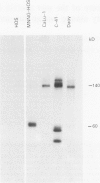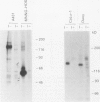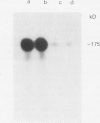Abstract
An in vitro autophosphorylation assay has been used to demonstrate that there is considerable variation in met associated protein kinase among human tumour cell lines. Of particular note was the very high level of autophosphorylation of the 140 kD met protein (p140met) in experiments with A431 human cervical carcinoma cells. In contrast in experiments with Daoy human medulloblastoma cells we failed to detect phosphorylation of p140met; instead a high level of phosphorylation of a 132 kD protein was observed. To help understand the basis for the variation in kinase activity and to learn more about the structure of the mature met protein we have analysed p140met in SDS-polyacrylamide gels under non-reducing conditions. Under these conditions the met protein had an apparent molecular weight of 165,000 indicating that the mature met protein may exist as an alpha beta complex in which p140met (designated the beta subunit) is joined by disulphide bonds to a smaller, 25 kD, alpha-chain. We have identified a potential proteolytic cleavage site with the sequence Lys-Arg-Lys-Lys-Arg-Ser at amino acids 303-308 in the human met protein that may account for cleavage of the met protein into alpha and beta subunits.
Full text
PDF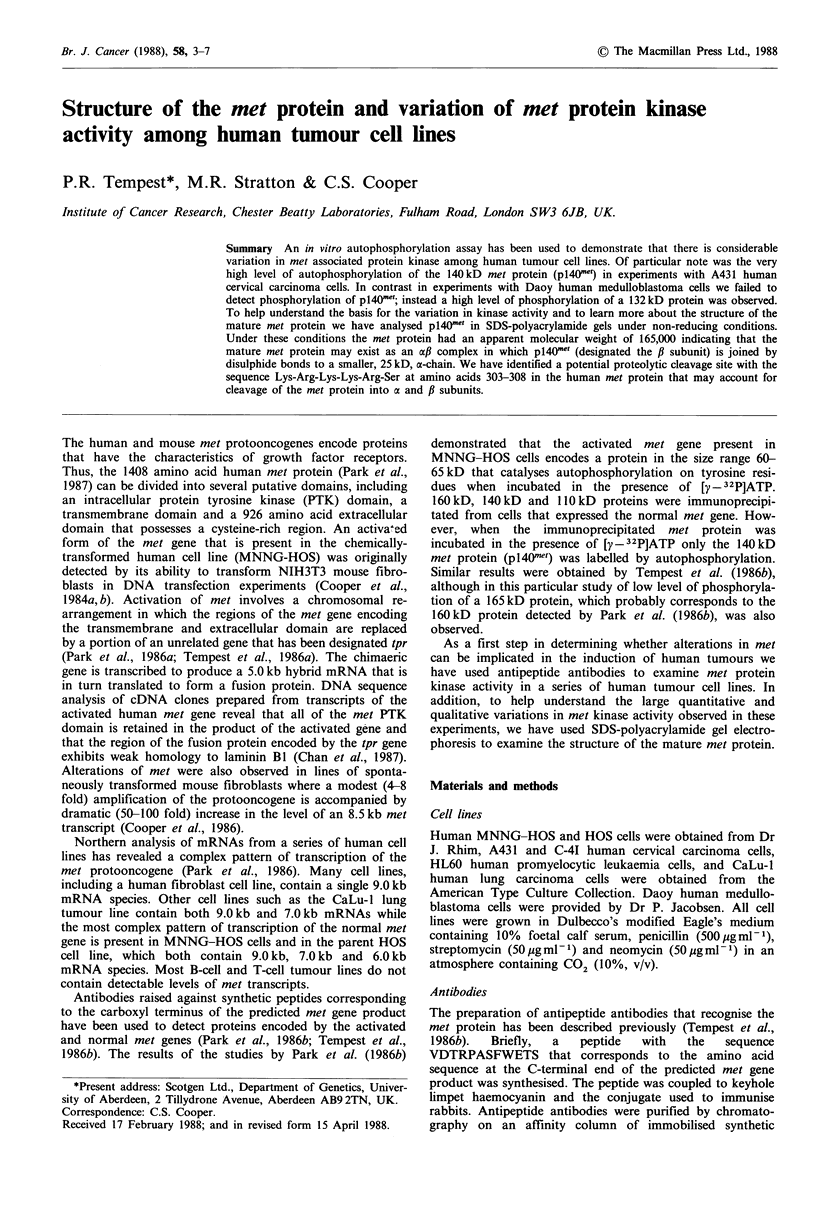
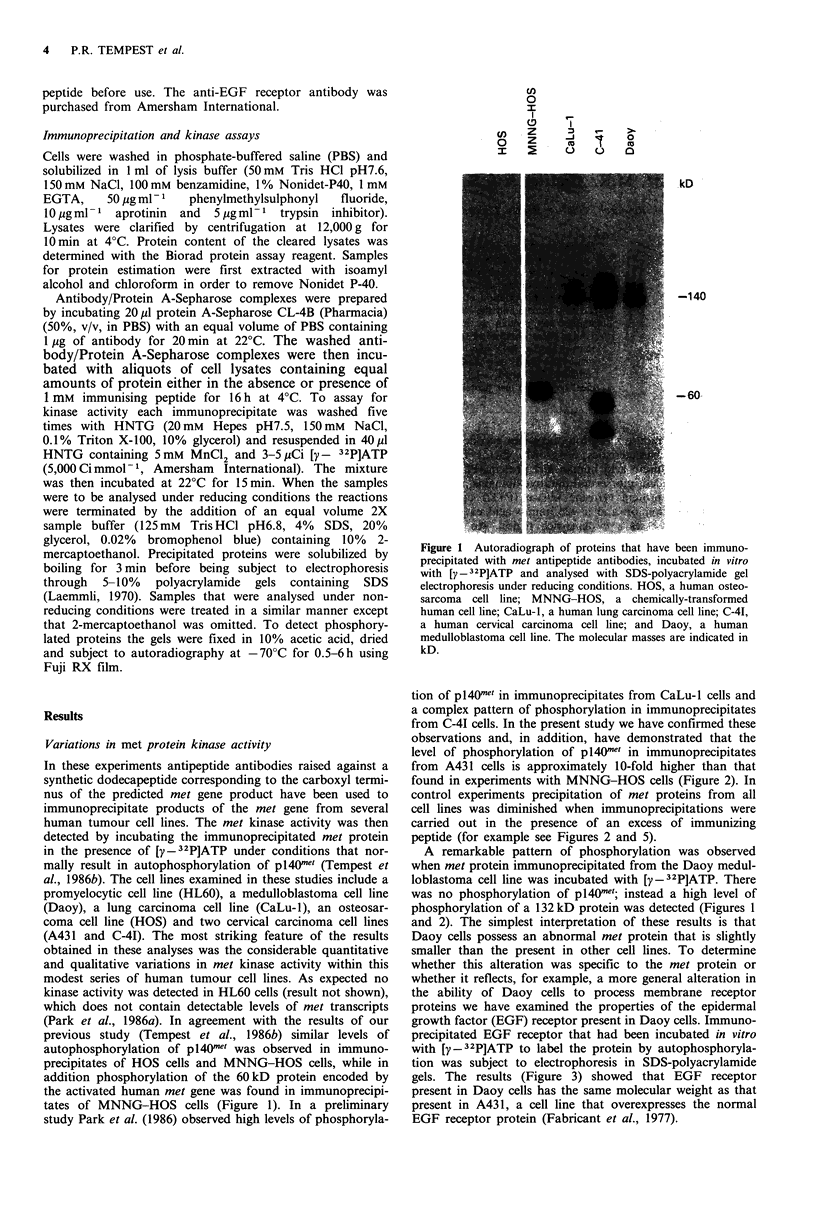
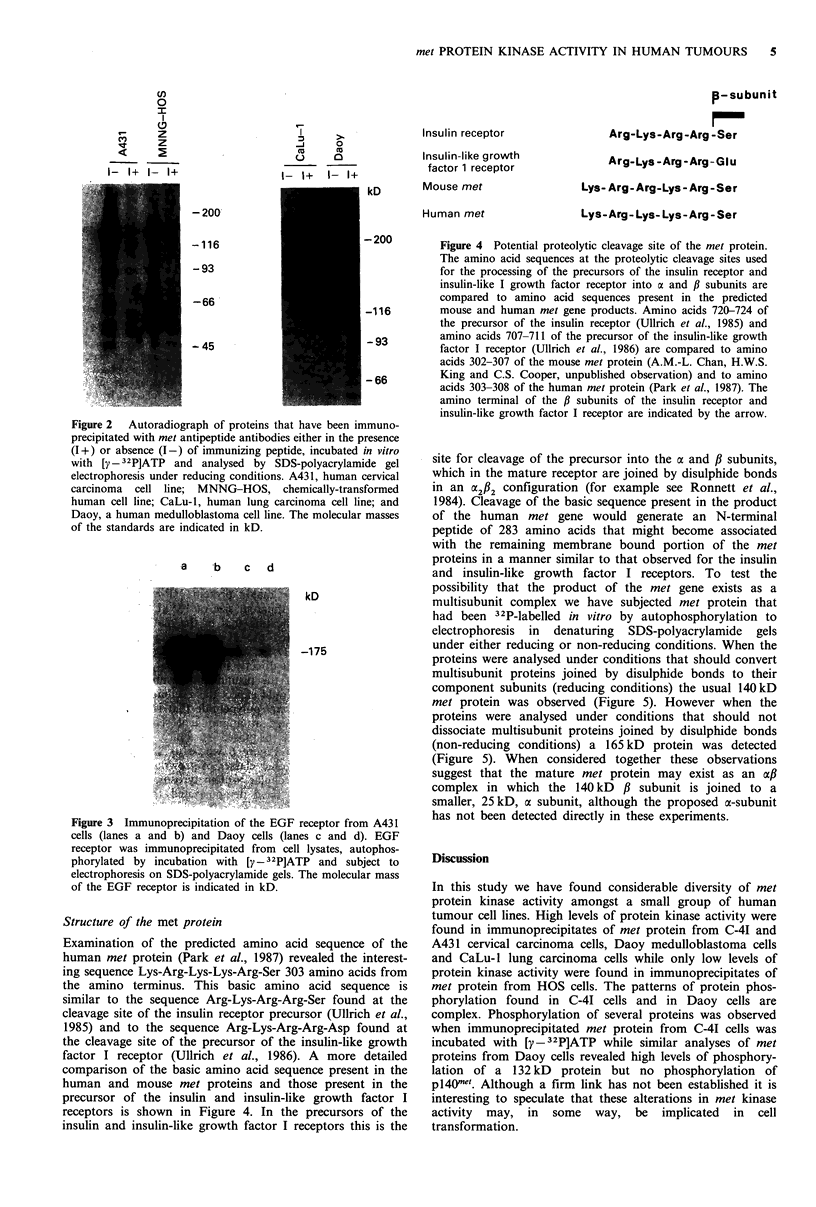
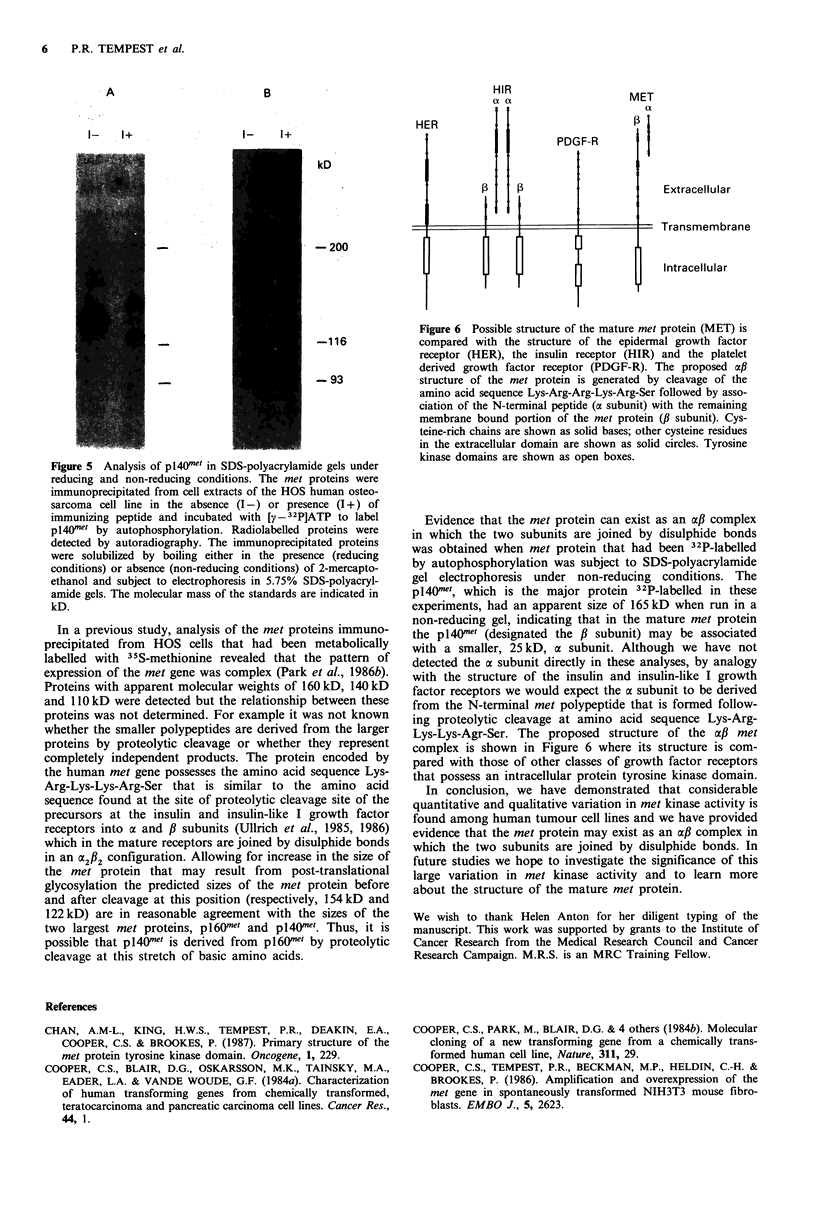
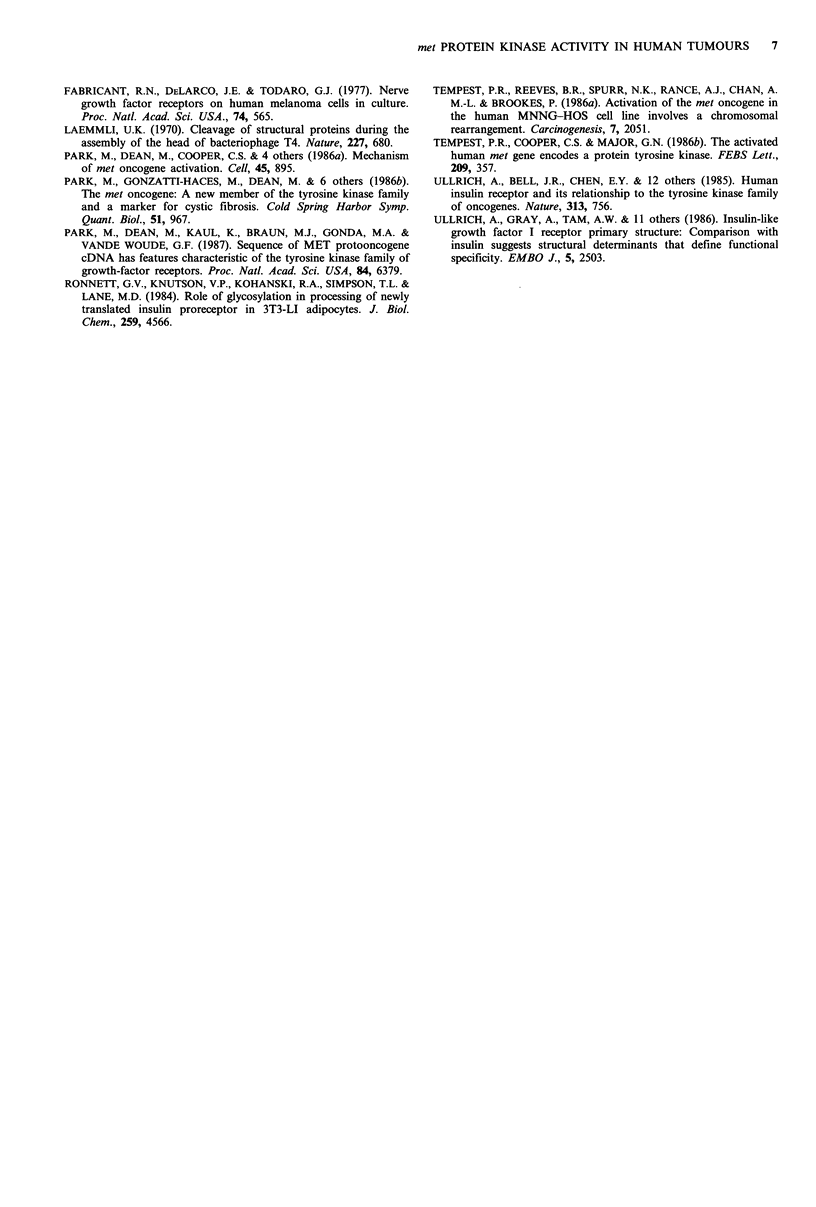
Images in this article
Selected References
These references are in PubMed. This may not be the complete list of references from this article.
- Chan A. M., King H. W., Tempest P. R., Deakin E. A., Cooper C. S., Brookes P. Primary structure of the met protein tyrosine kinase domain. Oncogene. 1987 May;1(2):229–233. [PubMed] [Google Scholar]
- Cooper C. S., Tempest P. R., Beckman M. P., Heldin C. H., Brookes P. Amplification and overexpression of the met gene in spontaneously transformed NIH3T3 mouse fibroblasts. EMBO J. 1986 Oct;5(10):2623–2628. doi: 10.1002/j.1460-2075.1986.tb04543.x. [DOI] [PMC free article] [PubMed] [Google Scholar]
- Fabricant R. N., De Larco J. E., Todaro G. J. Nerve growth factor receptors on human melanoma cells in culture. Proc Natl Acad Sci U S A. 1977 Feb;74(2):565–569. doi: 10.1073/pnas.74.2.565. [DOI] [PMC free article] [PubMed] [Google Scholar]
- Laemmli U. K. Cleavage of structural proteins during the assembly of the head of bacteriophage T4. Nature. 1970 Aug 15;227(5259):680–685. doi: 10.1038/227680a0. [DOI] [PubMed] [Google Scholar]
- Park M., Dean M., Cooper C. S., Schmidt M., O'Brien S. J., Blair D. G., Vande Woude G. F. Mechanism of met oncogene activation. Cell. 1986 Jun 20;45(6):895–904. doi: 10.1016/0092-8674(86)90564-7. [DOI] [PubMed] [Google Scholar]
- Park M., Dean M., Kaul K., Braun M. J., Gonda M. A., Vande Woude G. Sequence of MET protooncogene cDNA has features characteristic of the tyrosine kinase family of growth-factor receptors. Proc Natl Acad Sci U S A. 1987 Sep;84(18):6379–6383. doi: 10.1073/pnas.84.18.6379. [DOI] [PMC free article] [PubMed] [Google Scholar]
- Park M., Gonzatti-Haces M., Dean M., Blair D. G., Testa J. R., Bennett D. D., Copeland T., Oroszlan S., Vande Woude G. The met oncogene: a new member of the tyrosine kinase family and a marker for cystic fibrosis. Cold Spring Harb Symp Quant Biol. 1986;51(Pt 2):967–975. doi: 10.1101/sqb.1986.051.01.110. [DOI] [PubMed] [Google Scholar]
- Ronnett G. V., Knutson V. P., Kohanski R. A., Simpson T. L., Lane M. D. Role of glycosylation in the processing of newly translated insulin proreceptor in 3T3-L1 adipocytes. J Biol Chem. 1984 Apr 10;259(7):4566–4575. [PubMed] [Google Scholar]
- Tempest P. R., Cooper C. S., Major G. N. The activated human met gene encodes a protein tyrosine kinase. FEBS Lett. 1986 Dec 15;209(2):357–361. doi: 10.1016/0014-5793(86)81142-5. [DOI] [PubMed] [Google Scholar]
- Tempest P. R., Reeves B. R., Spurr N. K., Rance A. J., Chan A. M., Brookes P. Activation of the met oncogene in the human MNNG-HOS cell line involves a chromosomal rearrangement. Carcinogenesis. 1986 Dec;7(12):2051–2057. doi: 10.1093/carcin/7.12.2051. [DOI] [PubMed] [Google Scholar]
- Ullrich A., Bell J. R., Chen E. Y., Herrera R., Petruzzelli L. M., Dull T. J., Gray A., Coussens L., Liao Y. C., Tsubokawa M. Human insulin receptor and its relationship to the tyrosine kinase family of oncogenes. 1985 Feb 28-Mar 6Nature. 313(6005):756–761. doi: 10.1038/313756a0. [DOI] [PubMed] [Google Scholar]
- Ullrich A., Gray A., Tam A. W., Yang-Feng T., Tsubokawa M., Collins C., Henzel W., Le Bon T., Kathuria S., Chen E. Insulin-like growth factor I receptor primary structure: comparison with insulin receptor suggests structural determinants that define functional specificity. EMBO J. 1986 Oct;5(10):2503–2512. doi: 10.1002/j.1460-2075.1986.tb04528.x. [DOI] [PMC free article] [PubMed] [Google Scholar]



